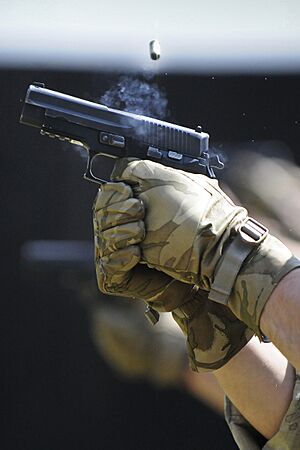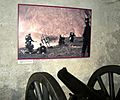Recoil facts for kids
Recoil, also known as kick, is what happens when a firearm moves backward and its front end (the muzzle) goes up right after it's fired. It's like a push-back from the powerful force of the bullet leaving the gun's barrel.
If you're shooting a handgun, you'll feel this kick in your hands and arms. If you're using a rifle or shotgun, you'll mostly feel it in your shoulder.
Contents
How Recoil Works
Recoil is explained by Newton’s third law of motion. This law basically says: "For every action, there is always an equal and opposite reaction."
In simpler words, when a bullet and hot gases shoot forward out of the gun, the gun itself pushes backward. Several things affect how strong this backward push is:
- Bullet Weight: The heavier the bullet or shell fired from the gun, the more recoil you will feel.
- Gun Weight: A heavier gun will have less recoil. It's harder to push a heavy object backward.
- Bullet Speed: The faster the bullet leaves the gun, the more recoil there will be. A very fast bullet can also make the recoil feel "sharper" or more sudden.
For example, a .22 Long Rifle bullet causes very little recoil. This makes it a great choice for new shooters. It's also good for practice because the bullets are inexpensive. Many people use it for target shooting.
On the other hand, a .500 S&W Magnum handgun bullet creates a very strong recoil. This recoil also feels much sharper because the bullet leaves the gun at a very high speed.
Dealing with Recoil
Many new shooters wonder if a gun will kick them hard. It's important to hold the gun firmly to help control the recoil. If you're using a handgun, always use both hands. For a shotgun or rifle, press it tightly against your shoulder and put your cheek on the gunstock.
However, instructors often say that dealing with recoil is mostly about your mind, not just your body. This means that even if you hold the gun perfectly, thinking too much about the kick can affect your shot.
What is Flinching?
Recoil anticipation is often called "flinching." It's when a shooter reacts to the loud noise and kick of the gun before it even happens. This reaction is not planned. The shooter knows the gun will make a loud noise and kick, so they might flinch at the last second. This often causes new shooters to shoot lower than where they aimed.
Another type of recoil anticipation is when new shooters unconsciously push the gun forward as they pull the trigger. Instructors can often only spot this when the shooter pulls the trigger on an empty gun. Then, they can see the gun move forward.
Jerking the Trigger
Another common issue is "jerking the trigger." Instead of pulling the trigger smoothly while focusing on the target, new shooters sometimes yank it quickly. If a right-handed shooter consistently hits low and to the left, they are usually jerking the trigger. They might not realize that pulling the trigger too fast can ruin their aim.
All these issues related to recoil anticipation can be fixed or reduced with practice. Good lessons on safe gun handling are also very important.
Images for kids
-
Recoil while firing Smith & Wesson Model 500 revolver
-
Photograph of the kickback of a cannon, taken in Morges Castle, Switzerland
See also
 In Spanish: Retroceso para niños
In Spanish: Retroceso para niños






